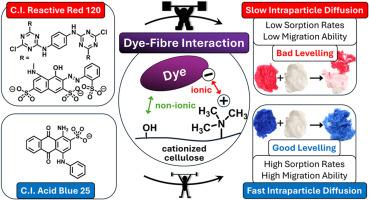纤维素阳离子化水平和分子染料结构对吸附和迁移行为的影响
IF 4.2
3区 工程技术
Q2 CHEMISTRY, APPLIED
引用次数: 0
摘要
在阳离子化纤维素纺织品的无盐活性染色中出现的不均匀着色是替代传统活性染色工艺的一个重大障碍。这种现象归因于染料分子在阳离子化纤维素上的快速吸附。然而,据推测,迁移能力和染料纤维相互作用的强度是导致流平性差的原因。在这项研究中,三种阴离子染料——C.I.酸性蓝25、C.I.活性蓝19和C.I.活性红120——被用来检查吸附率、迁移程度以及染料分子对阳离子纤维素纤维的相对亲和力。观察到,在低阳离子化水平下,吸附速率,特别是对较大的染料分子,被减慢。这种现象归因于缓慢的粒子内扩散。在迁移测试和染料交换实验中,观察到染料分子对阳离子化纤维素的相对亲和力决定了染料迁移和染料交换的程度。得出的结论是,在染色过程中观察到的不均匀性的主要因素是染料分子的高亲和力,因此低迁移能力,以及染料分子阳离子基的不完全饱和,即,当染料完全耗尽时,由于过高的阳离子水平而导致所需的色度,而不是吸附速度。本文章由计算机程序翻译,如有差异,请以英文原文为准。

Effect of cellulose cationisation level and molecular dye structure on sorption and migration behaviour
The occurrence of unlevel colouration in salt-free reactive dyeing of cationised cellulose textiles represents a significant hindrance in the replacement of conventional reactive dyeing processes. The phenomenon is attributed to the rapid adsorption of dye molecules onto cationised cellulose. However, it is hypothesised that the migration ability and the strength of the dye fibre interaction are responsible for poor levelling. In this study, three anionic dyes – C.I. Acid Blue 25, C.I. Reactive Blue 19 and C.I. Reactive Red 120 – were utilised to examine the rates of sorption, the extent of migration, and the relative affinity of the dye molecules to cationised cellulose fibres. It was observed that at low cationisation levels, the sorption rates, especially for larger dye molecules, were slowed down. This phenomenon is attributed to slow intraparticle diffusion. In migration test and dye exchange experiments, it was observed that the relative affinity of a dye molecule to cationised cellulose determines the extent of dye migration and dye exchange. It was concluded that the primary factors contributing to the non-uniformity observed in the dyeing process were the high affinity of dye molecules and thus low migration ability, and the incomplete saturation of cationic groups by dye molecules, i.e. when complete dye exhaustion occurs due to too high cationisation levels for the desired colour shade, rather than the rate of sorption.
求助全文
通过发布文献求助,成功后即可免费获取论文全文。
去求助
来源期刊

Dyes and Pigments
工程技术-材料科学:纺织
CiteScore
8.20
自引率
13.30%
发文量
933
审稿时长
33 days
期刊介绍:
Dyes and Pigments covers the scientific and technical aspects of the chemistry and physics of dyes, pigments and their intermediates. Emphasis is placed on the properties of the colouring matters themselves rather than on their applications or the system in which they may be applied.
Thus the journal accepts research and review papers on the synthesis of dyes, pigments and intermediates, their physical or chemical properties, e.g. spectroscopic, surface, solution or solid state characteristics, the physical aspects of their preparation, e.g. precipitation, nucleation and growth, crystal formation, liquid crystalline characteristics, their photochemical, ecological or biological properties and the relationship between colour and chemical constitution. However, papers are considered which deal with the more fundamental aspects of colourant application and of the interactions of colourants with substrates or media.
The journal will interest a wide variety of workers in a range of disciplines whose work involves dyes, pigments and their intermediates, and provides a platform for investigators with common interests but diverse fields of activity such as cosmetics, reprographics, dye and pigment synthesis, medical research, polymers, etc.
 求助内容:
求助内容: 应助结果提醒方式:
应助结果提醒方式:


